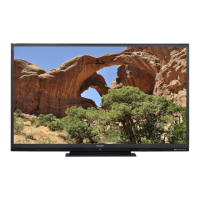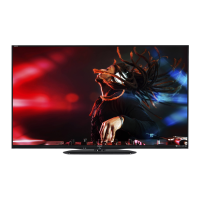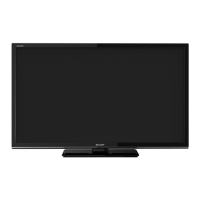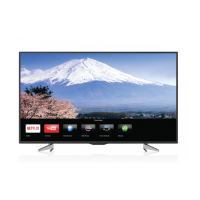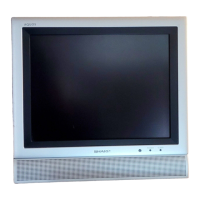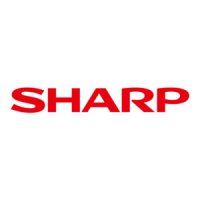
Do you have a question about the Sharp Aquos LC-52LE820M and is the answer not in the manual?
| Screen Size | 52 inches |
|---|---|
| Resolution | 1920 x 1080 pixels |
| Display Type | LCD |
| Backlight Type | LED |
| Response Time | 4 ms |
| Refresh Rate | 120 Hz |
| HDMI Ports | 4 |
| USB Ports | 2 |
| Viewing Angle | 176 degrees |
| Component Video Input | 1 |
| Composite Video Input | 1 |
| PC Input (D-Sub) | 1 |
| Built-in Speakers | Yes |
| Standby Power Consumption | 0.2 W |
| Tuner | DVB-T |
| Weight | 27.5 kg (with stand) |
| Dimensions (W x H x D) with Stand | 124.8 x 83.6 x 32.6 cm |
Safety guidelines for general use, cabinet, and panel maintenance.
Lists registered trademarks such as TruSurround HD, Dolby, HDMI, and DivX.
Crucial safety information to prevent injury, electric shock, and product damage.
Lists all items included with the TV product, such as remote and batteries.
Step-by-step instructions for physically attaching the TV stand.
Guidance on how to adjust the viewing angle of the TV screen.
Identifies front and rear TV components, and the remote control.
Pre-operation checks and setup steps before powering on the TV.
Guidance on connecting various external equipment like VCRs, DVD players.
Instructions for inserting batteries into the remote control unit.
Explains how to operate the TV using the remote control.
Procedures for powering the TV on, off, and placing it in standby mode.
Steps for the TV's first-time setup and automatic channel tuning.
Explains how to navigate and use the TV's menu system.
Guide to automatic channel scanning and tuning.
Various ways to change channels on the TV.
How to control the TV's sound level using the remote or panel.
Manual channel tuning, sorting, and erasing programmes.
Features like image freezing, mute, and audio output selection.
How to change the on-screen menu language for the TV.
Adjusting audio broadcast formats like MONO, STEREO, and bilingual.
How to set or clear a password for parental controls.
Function to lock TV or remote buttons to prevent unauthorized use.
Overview of HDMI CEC control for compatible system devices.
How to connect compatible audio systems or BD players for AQUOS LINK.
Basic operations for controlling connected devices via AQUOS LINK.
Feature for automatic TV power-up and content playback.
Procedures for operating connected devices like recorders and players.
How to play back content from connected devices like BD players.
Accessing external device setup menus through AQUOS LINK.
Choosing storage media (DVD, HDD) for CEC-compatible recorders.
Using the EPG to schedule timed recordings on a CEC recorder.
Routing TV audio to external audio systems via AQUOS LINK.
Adjusting audio modes for external sound systems.
Specifying which HDMI device to control in a daisy chain.
Configuring TV settings for HDMI input sources.
Setting the audio input for HDMI connections, especially with analogue audio.
How to choose and switch between the available input signals.
Assigning custom names to input ports for easier identification.
Choosing whether audio outputs through headphones or an external controller.
Configuring which input sources to bypass during source selection.
Adjusting colour standards (PAL, SECAM, NTSC) for video signals.
Enabling visual screen effects when changing channels.
Controlling the illumination of the TV's front panel LED indicator.
How to connect a PC to the TV using a VGA cable.
How to connect a PC to the TV using an HDMI cable.
Setting the audio input for PC connections via the INPUT3 terminal.
Controlling the TV from a PC via RS-232C, including communication settings.
Explains what Teletext is and the services it provides.
How to turn Teletext mode on and off using the remote control.
Describes the functions of remote control buttons for Teletext.
Steps to activate Teletext mode by selecting a channel or input.
How to set the correct Teletext language for display.
Instructions on how to navigate and display Teletext subpages.
How to display Teletext subtitles when available.
How to connect USB storage devices for media playback.
Overview of viewing photos, music, and videos from USB or network.
Choosing playback modes (Video, Music, Photo) and connecting devices.
Setting up the TV to access files from a home network server.
Settings for playing video files, including picture size adjustment.
How to play video content and use playback controls.
Controls for video playback operation.
Controls for full-screen video playback.
Adjusting the aspect ratio for video playback.
Settings for playing music files and selecting playback modes.
Displaying photo previews for selection.
Controls for music playback operation.
Controls for photo thumbnail navigation and slideshow.
How to view photos in full screen with rotation and navigation.
Settings available within the USB mode.
Settings available within the Home Network mode.
Configuring DivX playback, registration, and deregistration.
Lists supported file formats and specifications for USB playback.
Accessing convenient functions organised in a shortcut menu.
Solutions for common TV problems and potential causes.
Environmental operating guidelines and storage temperature recommendations.
Restoring TV settings to factory defaults.
Checking the current version of the TV's software.
Procedure for updating the TV's software using a USB device.
Details on software licensing, composition, and source code availability.
Physical dimensions and mounting hole details for the LC-40LE820M model.
Physical dimensions and mounting hole details for the LC-46LE820M model.
Physical dimensions and mounting hole details for the LC-52LE820M model.
Steps to detach the TV stand before wall mounting.
Safety and installation advice for wall-mounted TVs.
Guidance on using specific SHARP recommended wall brackets.
Adjusting TV audio settings specifically for wall-mounted installations.


